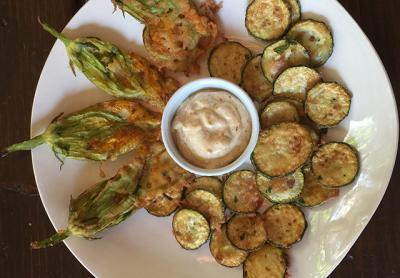Seasons by the Sea: Nothing Beats Olive Oil

Summer is upon us, so now it is time to think about salads and grilling, which means it’s also time to think about oils — olive for salads, peanut for frying up those zucchini blossoms and chips, flavored oils for marinades, etc.
Information about which oils are the most healthful is constantly changing. Have you hopped on the coconut oil bandwagon? Not me. As far as I’m concerned, it’s fine product to put on your body, not in it. For accurate and up-to-date information about coconut oil, you should consult the most recent studies by the American Heart Association and the Mayo Clinic. Nuff said.
Olive oil has been the number one fat in my house forever. I use good butter in moderation, margarine has never crossed my threshold, and for the occasional frying, I’ll use peanut oil, which has a high smoking point. The smoking point is the temperature at which the oil in the pan starts to burn. Not good. Other oils with a high smoking point are avocado (currently replacing coconut oil as the healthy and popular darling), almond, light olive oil, peanut, safflower, and sunflower. Oils that will start to burn between 225 and 330 degrees are flaxseed, butter, coconut, and walnut. Unrefined oils such as wheat germ oil should not be heated at all.
It’s simple logic that you should save your favorite extra virgin cold pressed olive oil for salads or dipping, in order to let the flavor shine through. Use your less expensive, light olive oils for sautéing and roasting. For a splurge, try a high quality walnut, hazelnut, pistachio, or pumpkin seed oil as an addition to salad dressings. A little bit goes a long way, and the pumpkin and pistachio oils have a strikingly brilliant emerald green hue. It is important to remember that certain nut oils go rancid fairly quickly, so they should always be stored in a cool, dark place. I keep some of them refrigerated.
There are two brands of organic olive oils with local connections. Illyrian Press olive oil is made from kalinjot olives, bottled in Albania, and brought to us by Andrew Strong and Rachael Faraone of Springs. Their award-winning oils can be found at Marder’s in Bridgehampton, Serene Green in Noyac, the Seafood Shop in Wainscott, and numerous other locations.
Arlotta Food Studio, which offers a variety of plain and flavored organic olive oils and balsamic vinegars, is produced by John Arlotta and his brother-in-law Mario Pecoraro of Water Mill. Their venture started with a peach farm and olive grove in California 10 years ago. They started the oil business eight years ago. The oils are available at over 50 farm stands and markets throughout New York, and the flavors range from the pure (silky and buttery!), to garlic, blood orange, rosemary, basil, lemon, and hot pepper. One of my favorites is the hot pepper oil, which Mario suggests slathering on a Browder’s bird from the North Fork. Sprinkle with herbs de Provence, salt and pepper, and roast. One of Mr. Pecoraro’s other favorite recipes is halibut drizzled with blood orange oil, a little honey and lemon, and then pan fried or grilled.
The lemon and blood orange oils are good for sweet as well as savory dishes. I’m thinking a lemony panna cotta with berries would be divine drizzled with a few drops of the blood orange oil.
When asked if they are planning to create any new flavors or if they’ve tried any that have failed, he said the lavender olive oil was not appealing and that someone had suggested they make a butter-flavored olive oil. Not happening.
Their olives are pressed in October, and the oils have a shelf life of approximately two years, whether opened or not.
Really good oils will be expensive, but they are worth it. My favorite commercial brand is Barbera Frantoia Extra Virgin, originally made with Sicilian olives, but now (like many other olive oils) made with a blend of olives from Spain, Greece, and other regions of Italy. This oil is green, fruity, herbaceous, and slightly peppery but not bitter at the end.
The varieties of olive oils in gourmet stores can be daunting. If you are impressed by that little dish of oil accompanying your bread course at a restaurant, ask the waiter to find out what it is. I have learned a lot about oils this way. Ask the chef at your favorite Italian restaurant what he or she uses. Chefs love to share cooking tips! You can also buy a bunch of bottles and host an olive oil tasting party. Take notes and send guests home with their favorite bottle.
Whether you cook, drizzle, dip, marinate, or fry, here are some recipes to inspire you. The first two are really more like ideas for cocktail parties. Use your favorite and best extra virgin olive oils for both.
Click for recipes
